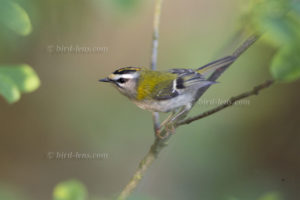 Coniferous forest and a high-pitched ziziziziit, practically always at the same frequency. You cannot go wrong in the combination. The song is the best field mark for the Firecrest (Regulus ignicapilla).
Coniferous forest and a high-pitched ziziziziit, practically always at the same frequency. You cannot go wrong in the combination. The song is the best field mark for the Firecrest (Regulus ignicapilla).
If you made the Firecrest approach you closer, for example by imitated the “song”, you quickly see a bright orange red crest, which is set up in excitement. Both sexes have a black eye-streak and on the sides of the neck in front of the wing-bow each a large olive-yellow spot.
The Firecrest is like the winter Goldcrest a lightweight. Regularly it is to be found near high conifers. Here also likes to another even smaller bird on – the Goldcrest (Regulus regulus). The Goldcrest is only about nine inches big bird. It is the smallest bird in Europe. He is very vocal and his reputation fine and very high. The Goldcrest happily stays in treetops and hops and jumps restlessly between the spruce branches. In contrast to the Goldcrest that looks almost identical, the Firecrest has a wide white stripe over the eye.
Firecrests pick and pick their food more superficially from twigs. Sometimes branches and leaves are visited in a buzzing flight. Firecrests need to eat about their own body weight during one day. That’s why you can see them constantly foraging. In contrast to the more resilient twins, the summer gold chicken leaves the winter areas for the most part. It is less bound to spruce than the Goldcrest and uses conifers as well as deciduous trees.
In the next few weeks, ID-confusion can happen quickly. As a not so rare observer appears at the beginning of October namely the Yellow-browed Warbler (Phylloscopus inornatus). The Yellow-browed Warbler is a typical small foliage singer with a fine, pointed beak and a relatively short tail. In appearance, this Phylloscopus-Warbler actually resembles a Firecrest. Depending on how it positions itself, it does not look more delicate than the native Chiffchaff (Phylloscopus collybita), although his body length is eight millimeters shorter. The top of the head is olive green with a slightly lighter rump and upper tail ceilings. Two distinct, but differently intense wing bands, caused by the bright seams of the secondaries, are usually the most striking feature. The top of the head is dark green with a lighter hint of a lighter vertex. The name comes form the lightgreen-yellow superciliary stripe. This superciliary stripe extends quite far back and is bounded below by a black eyeliner.
Where forest damage occurs, Goldcrest and Firecrest quickly get into trouble: the thinned branches no longer offer them adequate protection and the food supply is severely restricted.
To cope with the growing demand for top shots of the rarer species of the Palearctic Bird-Lens is keen to enrich the range of pictures of birds you can find in the western Palearctic. Trips to remote places to capture images not only of rare birds of western Palearctic were very successful. The nice image of the blog is only a first impression, what you will find in the gallery in the “Picture Shop” very soon. Just give bird-lens.com a message, if bird-lens.com could serve you with an image needed before the new pictures are online.